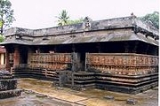
Keladi
Encyclopedia

Shimoga District
Shimoga District is a district in the Karnataka state of India. A major part of Shimoga District lies in the Malnad region of the Western Ghats, a hilly area known for its green forests, plentiful rainfall, and as the source of many of the area's rivers. Shimoga City is the administrative centre...
of the state of Karnataka
Karnataka
Karnataka , the land of the Kannadigas, is a state in South West India. It was created on 1 November 1956, with the passing of the States Reorganisation Act and this day is annually celebrated as Karnataka Rajyotsava...
in India
India
India , officially the Republic of India , is a country in South Asia. It is the seventh-largest country by geographical area, the second-most populous country with over 1.2 billion people, and the most populous democracy in the world...
.
Located about 8 KM from Sagara town.
History
It is interesting as the place whence the Ikkeri chiefs derived their origin, which is thus related :-Two brothers named Chavuda Gauda and Bhadra Gauda, living in the village of Hale-bayal, in the Keladi taluk of the Chandragutti paragana, had two servants or slaves, named Yadava and Murari, who cultivated their masters' fields. A cow they had was discovered to shed her milk over a certain ant-hill, which, on digging into, Chavuda Gauda found, contained a linga, over which, therefore, he built a small temple. A little time after, the servants, when ploughing, turned up an old sword, which they put into the thatch of the house, intending to make a scythe of it. But they discovered that if a crow perched on the shed the sword leaped out in the form of a serpent and killed it. On this, Chavuda Gauda took it and, carefully cleaning it, kept in his house, giving it the name of Nagaramuri. At another time, the ploughshare struck against the ring of a cauldron, which contained treasure. Afraid to disturb it, Chavuda Gauda covered it up again, but that night had a dream, in which he was directed to offer a human sacrifice and take the treasure. On hearing this, his two slaves volunteered to be the victims on condition that their memory was preserved. All the preparations being made, the place was dug up at night and the slaves, after ablutions, prostrated themselves to the cauldron and were beheaded with the sword Nagaramuri.
With this accession of wealth, the Gaudas raised a small force and began to subdue the neighbouring villages. But they were seized and sent to Vijayanagar by order from the king, and there put into custody. Hearing that a Palegar near Balihalu was rebellious, they made an offer through the court musicians to punish him if allowed to do so. Permission being given, they went with a force and killed the Palegar, on which they were released and confirmed in the possession of the places they had captured, receiving from the king a seal (sikha moharu). The town of Keladi was then founded, together with the temple of Rameshwara.
One day while the Gauda was hunting, a hare turned upon his hounds, indicating heroic virtue in the soil of the place in which this occurred. He therefore removed his town to the spot, calling Ikkeri. His son and successor, with the sanction of Sadasiva Raya, the Vijayanagar sovereign, took the name of Sadasiva-Nayak.
Two mounds, called Kalte, at the entrance to Keladi are pointed out as the scene of the human sacrifices.
The principal building in the place is the double temple of Rameshwara and Virabhadra, a large and plain structure built in the Hoysala-Dravida style.
After the disintegration of Vijayanagar Empire in the Battle of Talikota
Battle of Talikota
The Battle of Talikota , a watershed battle fought between the Vijayanagara Empire and the Deccan sultanates, resulted in a rout of Vijayanagara, and ended the last great Hindu kingdom in South India...
, the Keladi Nayaka
Keladi Nayaka
Keladi Nayaka Kingdom were an important ruling dynasty of post-medieval Karnataka, India. They initially started to rule as a feudatory of the Vijayanagar Empire...
s created an independent kingdom and it remained so until it was annexed to Mysore Kingdom by Hyder Ali
Hyder Ali
Hyder Ali was the de facto ruler of the Kingdom of Mysore in southern India. Born Hyder Naik, he distinguished himself militarily, eventually drawing the attention of Mysore's rulers...
.
Shivappa Nayaka
Shivappa Nayaka
Shivappa Nayaka , also known as Keladi Shivappa Nayaka, was a notable ruler of the Keladi Nayaka Kingdom. The Keladi Nayakas were successors of the Vijayanagara Empire in the coastal and Malnad districts of Karnataka, India, in the late 16th century...
and Chennamma
Keladi Chennamma
Keladi Chennamma was the Queen of Keladi Kingdom in Karnataka. She was daughter of Siddappa Setty of Kundapur who is from a Lingayathi Banajigaru Community. She married King Somashekara in 1667. After Somashekara, she became the queen of Keladi Nayaka dynasty who fought the Mughal Army of Aurangzeb...
were the rulers of this kingdom.

